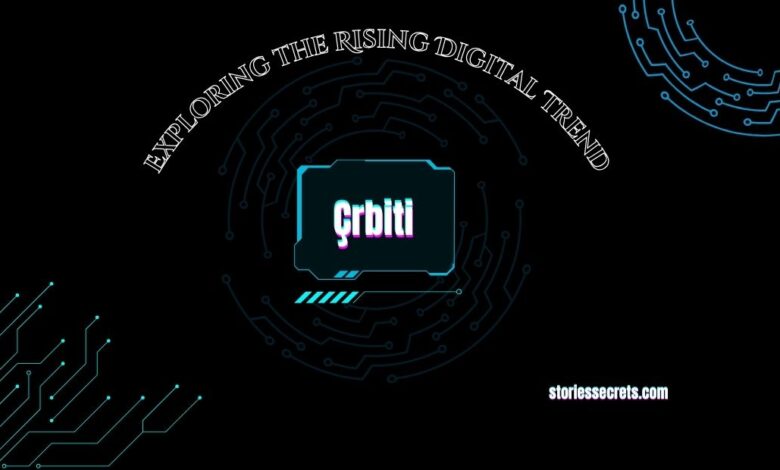Çrbiti: Exploring the Rising Digital Trend

In the ever-evolving landscape of technology and innovation, the term “Çrbiti” has begun to make waves. While it may still be unfamiliar to some, It is emerging as a significant concept, drawing attention for its potential applications across industries. Whether you are a tech enthusiast or simply curious about the next big thing, this article will guide you through the essentials of It, its implications, and address frequently asked questions about this intriguing development.
What is Çrbiti?
Çrbiti is a conceptual framework or technology that bridges digital and physical worlds through innovative means. Rooted in the integration of artificial intelligence (AI), blockchain, and Internet of Things (IoT), It focuses on creating a seamless interaction between real-world processes and their digital counterparts. While its exact origin remains speculative, It has quickly gained traction in fields like finance, healthcare, logistics, and entertainment.
At its core, It is about enhancing efficiency, transparency, and connectivity. By leveraging decentralized systems, automated algorithms, and real-time data sharing, it seeks to revolutionize how industries operate.
How Does Çrbiti Work?
The mechanics of It revolve around three foundational technologies:
- Artificial Intelligence (AI)
Çrbiti uses AI algorithms to process and analyze data at lightning speed, enabling predictive insights and adaptive decision-making. - Blockchain Technology
With blockchain’s secure and transparent infrastructure, It ensures data integrity, traceability, and decentralized control over operations. - Internet of Things (IoT)
IoT devices play a crucial role in It by providing real-time data from interconnected systems, bridging the gap between digital systems and physical assets.
These components work in synergy to create a dynamic ecosystem where data flows seamlessly, tasks are automated, and processes are optimized.
Applications of Çrbiti
It’s versatility makes it applicable across a wide range of industries.
- Finance
In the financial sector, It enhances transparency in transactions, reduces fraud through blockchain technology, and provides real-time analytics for investment strategies. - Healthcare
It enables better patient care by integrating IoT-enabled medical devices with AI-driven diagnostics, ensuring accurate treatment plans and efficient record management. - Logistics and Supply Chain
Through real-time tracking, automated inventory systems, and transparent ledger systems, It improves the efficiency of supply chains. - Entertainment
Çrbiti allows for innovative user experiences in gaming, virtual reality, and digital content distribution, creating new revenue models and engaging audiences in unique ways. - Smart Cities
Urban development projects can leverage It for traffic management, energy optimization, and public safety initiatives.

Benefits of Çrbiti
The adoption of it
brings numerous benefits to industries and consumers alike:
- Efficiency: Time and resources are saved when repetitive processes are automated.
- Transparency: Blockchain ensures data is secure and verifiable.
- Connectivity: IoT fosters better communication between devices and systems.
- Scalability: Çrbiti solutions can grow with the needs of a business or industry.
- Cost-Effectiveness: Streamlined processes reduce operational costs.
Challenges Facing Çrbiti Adoption
Despite its immense potential, the road to widespread adoption of It is not without obstacles. Here are some of the key challenges that stakeholders must address:
- High Implementation Costs
Developing and deploying It systems require significant investment in advanced technologies, infrastructure, and skilled personnel. - Data Privacy and Security Concerns
While blockchain ensures data integrity, integrating IoT devices and AI raises concerns about privacy and data misuse. Companies need to implement robust security measures to gain user trust. - Interoperability Issues
Integrating diverse systems into a unified Çrbiti ecosystem requires seamless communication between devices and platforms. Lack of standardization across industries can hinder this process. - Regulatory and Legal Barriers
Governments worldwide are still catching up with regulating emerging technologies like blockchain and AI. Unclear legal frameworks may slow the adoption of It. - Need for Specialized Talent
Implementing it requires expertise in multiple fields, including AI, blockchain, and IoT. The current talent gap in these areas can pose a challenge for businesses.
How Businesses Can Prepare for Çrbiti
For organizations aiming to leverage It, preparation is key.
- Invest in Research and Development
Businesses should allocate resources to understand Çrbiti’s potential applications within their sector and experiment with pilot projects. - Collaborate with Tech Partners
Partnering with technology providers and startups specializing in AI, blockchain, or IoT can accelerate the implementation of Çrbiti solutions. - Upskill the Workforce
Training employees in cutting-edge technologies ensures the company has the talent needed to adapt to Çrbiti systems. - Adopt a Phased Approach
Instead of a complete overhaul, businesses can start small by implementing It in specific areas, such as supply chain optimization or customer analytics. - Engage with Regulatory Authorities
Companies should proactively work with regulators to ensure compliance and advocate for policies that support technological innovation.
The Global Impact of Çrbiti
The adoption of it has the potential to drive significant change at a global scale. From reducing waste in supply chains to enhancing access to healthcare in remote areas, It could be a game-changer for both developed and developing nations.
Economic Growth
By automating processes and reducing inefficiencies, It can boost productivity and drive economic growth. Businesses can scale operations more effectively, leading to increased revenues and job creation.
Sustainability
It’s data-driven insights can help industries reduce their environmental impact. For example, IoT devices can monitor energy usage, while AI can optimize resource allocation in real time.
Improved Quality of Life
In smart cities, Çrbiti can improve urban living conditions through better traffic management, efficient waste disposal, and enhanced public safety. In healthcare, it can facilitate quicker diagnoses and personalized treatments.
FAQs About Çrbiti
- What is Çrbiti, and how is it different from other technologies?
It is a framework that combines AI, blockchain, and IoT to optimize operations. Its unique integration of these technologies sets it apart from traditional systems. - Is Çrbiti a specific product or a concept?
It is more of a concept or ecosystem rather than a singular product. It represents a way of designing systems to enhance functionality and connectivity. - Which industries can benefit the most from it?
While almost all industries can adopt Çrbiti, finance, healthcare, logistics, and smart cities stand out as key beneficiaries. - What challenges does Çrbiti face?
Challenges include high initial implementation costs, data privacy concerns, and the need for widespread IoT infrastructure. - How can businesses adopt Çrbiti?
Businesses can start by integrating AI-driven analytics, adopting blockchain for secure transactions, and implementing IoT devices for real-time data collection.
The Future of Çrbiti
The potential of It is vast, with experts predicting its widespread adoption in the coming years. As technology continues to advance, it could become the foundation for more interconnected, intelligent systems. Its ability to adapt to various industries makes it a promising tool for innovation and growth.
For individuals and businesses alike, staying informed about It and its developments could open doors to exciting opportunities. Whether it’s improving operational efficiency or creating novel consumer experiences, It is poised to leave a lasting impact on the digital and physical worlds.
Conclusion
Çrbiti represents a forward-thinking approach to technology, combining AI, blockchain, and IoT to transform how industries function. Its applications are as diverse as its potential, making it a topic worth exploring. As we move towards a more interconnected future, it is not just a buzzword—it’s a glimpse into what’s possible when innovation meets purpose.




